December Key Figures
Key Figures |
|  |
 |  | Sep Qtr 2003 | Dec Qtr 2003 | Sep Qtr 2003 to Dec Qtr 2003 |  |
 |  | $m | $m | % change |  |
TREND ESTIMATES |  |
|  |
| Balance on current account | -12,135 | -12,390 | -2 |  |
| Balance on goods and services | -6,394 | -6,536 | -2 |  |
| Net income | -5,725 | -5,821 | -2 |  |
SEASONALLY ADJUSTED |  |
|  |
| Balance on current account | -12,093 | -12,012 | 1 |  |
| Balance on goods and services | -6,436 | -6,036 | 6 |  |
| Net income | -5,714 | -5,888 | -3 |  |
ORIGINAL |  |
|  |
| Balance on current account | -13,272 | -12,156 | 8 |  |
| Balance on capital and financial account | 12,931 | 12,341 | -5 |  |
Levels at end of period |  |
|  |
| Net international investment position (IIP) | 453,628 | 468,606 | 3 |  |
 | Net equity | 90,417 | 94,117 | 4 |  |
 | Net debt | 363,211 | 374,488 | 3 |  |
|  |
CURRENT ACCOUNT, Main aggregates—Trend estimates at current prices
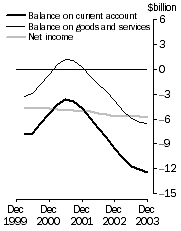
| International investment, Levels at end of period
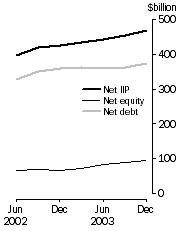
|
December Key Points
BALANCE OF PAYMENTS
- The current account deficit, seasonally adjusted, fell $81m to $12,012m. The deficit on the balance of goods and services fell $400m to $6,036m. The income deficit rose $174m to $5,888m.
- In seasonally adjusted chain volume terms there was an increase of $856m in the deficit on goods and services. This could be expected to contribute -0.5 percentage points to growth in the December quarter 2003 volume measure of GDP.
INTERNATIONAL INVESTMENT POSITION
- Australia's net IIP rose to a net liability of $469b at 31 December 2003. Net foreign debt was $374b, an increase of $11b, due to net debt inflows of $19b and other changes of $3b, partially offset by an exchange rate decrease of $11b, caused by the continuing appreciation of the $A. Net equity liabilities rose by $4b to $94b at 31 December 2003.
Notes
CHANGES IN THIS ISSUE
Format and Contents
A number of changes to the format and content of this publication have been introduced. These changes include the deletion of some tables, the addition of a table and changes to the format and content of other tables. As a consequence, the numbering of some tables has changed. The numbering of AusStats tables has not changed and Appendix 3 lists the table numbers in this publication against the equivalent AusStats tables. All data previously available from AusStats and Time Series Spreadsheets continue to be available.
This issue introduces the release of detailed international investment position (IIP) data for the latest quarter. Previous issues of this publication have provided only broad IIP aggregates with the detail published for the previous quarter. See paragraph 7 of the Explanatory Notes concerning the quality of the latest quarter data. As a consequence of this change, detailed data for the September quarter 2003 are provided in supplementary tables in Appendix 2.
Seasonal Factors
The seasonally adjusted and trend estimates of the other non-rural goods credits component of the current account have been revised. Revised historical and new forward seasonal factors are available in the electronic spreadsheets associated with this publication (see 5302.0, Table 95, for quarterly seasonal factors).
Revisions
Table 34 summarises revisions, in original current price terms, since the last issue of this publication, for the last three years and six quarters.
Incorporation of the latest survey and administrative data has resulted in revisions to the current account back to September quarter 2002, increasing the 2002-03 current account deficit by $341m. The financial account and international investment position have been revised back to September quarter 2002, increasing Australia's net IIP liability as at 30 September 2003 by $0.9b.
ROUNDING
Discrepancies may occur between data in this publication and the same aggregates from other sources, and between sums of component items and totals due to rounding.
Inquiries
For further information about these and related statistics, contact the National Information and Referral Service on 1300 135 070 or Tom Jebbink on Canberra 02 6252 5540 for balance of payments estimates.
ANALYSIS AND COMMENTS
Balance of Payments
Current Account
The trend estimate of the balance on current account for the December quarter 2003 was a deficit of $12,390m, an increase of $255m (2%) on the deficit recorded for the September quarter 2003. The main contributor to the increase in the deficit was goods and services credits, which fell $412m, partially offset by a fall in goods and services debits of $270m.
In seasonally adjusted terms, the current account deficit fell $81m to $12,012m in the December quarter 2003. The net deficit on goods fell $81m (1%) to $6,049m. The net services surplus of $13m was a turnaround of $319m on the deficit of $306m in September quarter 2003. The net deficit on income rose $174m (3%) to $5,888m.
Goods and Services
The trend estimate of the balance on goods and services at current prices was a deficit of $6,536m, an increase of $142m (2%) on the September quarter 2003 deficit of $6,394m.
In seasonally adjusted current price terms, the balance on goods and services was a deficit of $6,036m. The deficit on goods was $6,049m, a decrease of $81m on the deficit of $6,130m in the September quarter 2003. Lower goods imports, down $317m, were partly offset by lower goods exports, down $236m. Goods debits recorded decreases in intermediate and other merchandise goods, down $388m (3%) and in capital goods, down $80m (1%). Consumption goods rose $153m (1%). The fall in goods credits was driven by falls in non-rural goods, down $296m (2%), and other goods, down $307m (14%), partly offset by a rise in rural goods, up $367m (7%).
In seasonally adjusted volume terms, the deficit on goods and services was $10,340m, an increase of $856m on the $9,484m deficit recorded for the September quarter 2003. The goods deficit rose $620m to $8,567m as goods debits rose $1,133m (3%) and goods credits rose $513m (2%). The net services balance was a deficit of $1,773m, a $236m increase on the September quarter 2003 deficit of $1,537m.
The increase of $856m in the deficit on goods and services in volume terms could be expected to make a contribution to growth of -0.5 percentage points in the December quarter 2003 volume measure of GDP, assuming no significant revision to the GDP chain volume estimate for the September quarter 2003.
GOODS AND SERVICES(a)
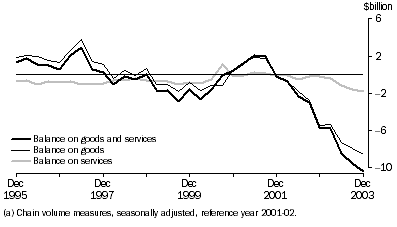
Goods Credits
The trend estimate of goods credits fell $775m (3%) to $25,669m in the December quarter 2003. Seasonally adjusted, goods credits were $26,051m, down $236m (1%) on the September quarter 2003, driven by decreases in exports of non-rural and other goods, partly offset by increases in rural goods.
Non-rural goods (seasonally adjusted, current prices) fell $296m (2%) to $18,488m, with volumes up 2% and prices down 3%. Exports of other mineral fuels recorded the largest decrease, down $283m (12%), with the fall entirely due to a drop in volume; followed by transport equipment, down $277m (19%), with volumes down 14% and prices down 6%; and machinery, down $119m (7%), with volumes down 3% and prices down 4%. Partly offsetting these decreases was a rise in exports of metal ores and minerals, up $228m (7%), with volumes up 9% while prices fell 2%.
Rural goods (seasonally adjusted, current prices) rose $367m (7%) to $5,645m, with volumes up 8% while prices fell 1%. The largest increases were in cereal grains and cereal preparations, up $278m (36%), with volumes up 43% while prices fell 5%, and in meat and meat preparations, up $167m (14%), with volumes up 4% and prices up 10%. Partly offsetting these increases were falls in other rural goods, down $55m (2%), due to decreased prices, and in wool and sheepskins, down $23m (3%), with volumes up 6% while prices fell 9%.
Other goods (seasonally adjusted, current prices) recorded a decrease, down $307m (14%), driven by goods for processing, down $286m.
GENERAL MERCHANDISE CREDITS(a)
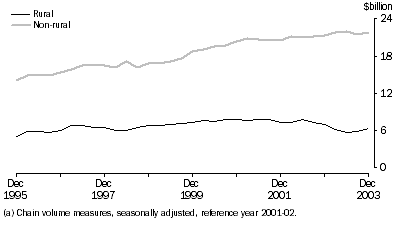
Goods Debits
The trend estimate of goods debits fell $578m to $32,049m in the December quarter 2003. In seasonally adjusted current price terms, goods debits fell $317m (1%) to $32,100m.
Intermediate and other merchandise goods (seasonally adjusted, current prices) fell $388m (3%) to $12,660m. The largest falls were in fuels and lubricants, down $153m (7%), with volumes down 5% and prices down 2%; parts for transport equipment, down $148m (8%), with volumes down 7% and prices down 1%; and other merchandise goods, down $123m (33%), with volumes down 30% and prices down 4%. Partly offsetting these decreases were rises in organic and inorganic chemicals, up $114m (16%), with volumes up 15% and prices up 1% and processed industrial supplies n.e.s., up $113m (4%) with volumes up 9% while prices fell 4%.
Capital goods imports (seasonally adjusted, current prices) fell $80m (1%) to $7,685m, with a rise in volumes of 4% and a fall in prices of 5%. This decrease was driven by imports of civil aircraft, down $84m (9%), due to a fall in volumes, and ADP equipment, down $36m (3%), with volumes up 8% while prices fell 10%. Partly offsetting these decreases was a rise in imports of industrial transport equipment, up $67m (7%), with volumes up 9% while prices fell 2%.
Consumption goods imports (seasonally adjusted, current prices) rose $153m (1%) to $10,380m, with a rise in volumes of 4% while prices fell 3%. This increase was driven by consumption goods n.e.s., up $87m (3%), with volumes up 6% while prices fell 3%, toys, books and leisure goods, up $77m (9%), with volumes up 14% while prices fell 5%, and non-industrial transport equipment, up $38m (1%) with volumes up 3% while prices fell 1%. Partly offsetting these increases was a fall in food and beverages, mainly for consumption, down $49m (4%), with volumes and prices both down 2%.
GENERAL MERCHANDISE DEBITS(a)
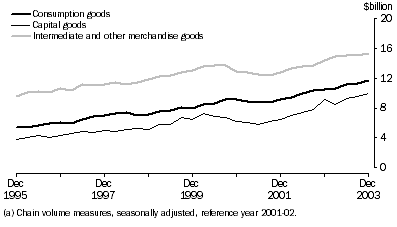
Services
The trend estimate of net services was a deficit of $156m, down $55m on the September quarter 2003 deficit. In seasonally adjusted terms, net services recorded a surplus of $13m, a turnaround of $319m on the deficit of $306m for the September quarter 2003.
Services credits, in seasonally adjusted terms at current prices, rose $787m (10%) to $8,771m, due mainly to an increase in volumes. Services debits, in seasonally adjusted terms at current prices, rose $468m (6%) to $8,758m, with volumes up 10% while prices fell 4%. The largest increases in both services credits and debits were in travel services, largely due to increased international travel after the reduced levels earlier in the year following the SARS travel warnings. Travel associated with the Rugby World Cup also contributed to the increase in credits.
Implicit Price Deflator
In seasonally adjusted terms, the implicit price deflator (IPD) for total goods and services credits fell 1.6%. In original terms, it fell 1.5%. The chain Laspeyres price index for goods and services credits fell 1.6%, indicating that compositional effects had a small upward influence on the movement in the IPD. The IPD for goods credits fell 2.3% and the IPD for services credits rose 0.7%.
The total goods and services debits IPD fell 3.9% in seasonally adjusted terms. In original terms, it fell 3.7%. The chain Laspeyres price index for debits fell 3.4%, indicating that compositional effects had a downward influence on the movement in the IPD.
IMPLICIT PRICE DEFLATOR(a)

Relationship to IPI and EPI
The goods export IPD (in original terms) fell 2.3% while the chain Laspeyres price index for goods exports fell 2.5% and the exports price index (EPI) fell 3.1% during the December quarter 2003.
During the December quarter 2003, the goods imports IPD (in original terms) fell 3.6% and the chain Laspeyres price index for goods imports fell 3.3%. The import price index (IPI) fell 2.9%.
Income
The trend estimate of the net income deficit rose $96m to $5,821m.
In seasonally adjusted terms, the net income deficit rose $174m (3%) to $5,888m. Income credits fell $53m (1%) to $3,522m and income debits rose $121m (1%) to $9,410m.
In original terms, income credits rose $140m (4%) to $3,630m and income debits fell $672m (7%) to $8,853m.
Net income
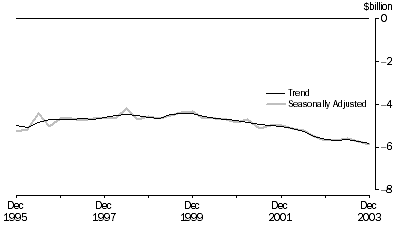
Current Transfers
In seasonally adjusted terms, net current transfers was a deficit of $88m, a turnaround of $145m on the $57m surplus recorded in the September quarter 2003. Current transfer credits fell $33m and debits rose $112m.
Capital and Financial Account
Capital Account
In original terms, the capital account surplus was $269m, down $101m on the September quarter 2003 surplus. Capital transfer credits fell $35m (5%) to $635m and capital transfer debits rose $48m (16%) to $344m.
Financial Account
Direct investment in Australia recorded an inflow of $0.5b in the December quarter 2003, a $5.7b decrease on the September quarter 2003 inflow of $6.2b. Australia's direct investment abroad recorded an outflow of $14.5b, up $13.9b on the previous quarter's outflow of $0.5b. This is the highest level of direct investment abroad recorded in the series, which begins in September quarter 1988, and is due to several large acquisitions of non-resident companies by Australian businesses. This was the twelfth consecutive quarterly outflow, bringing the total outflow on Australia's direct investment abroad to $59.7b from the March quarter 2001.
Portfolio investment recorded a net inflow of $25.7b, up $8.3b from the net inflow of $17.4b in the September quarter 2003. This is the highest level of portfolio investment recorded in the series which begins in September quarter 1988. Large debt security issues were made to fund acquisition activity, rollover existing debt and to move domestic issues offshore to take advantage of interest rate differentials.
Other investment recorded a net inflow of $4.8b, a turnaround of $15.6b on the net outflow of $10.9b recorded in the September quarter 2003.
Reserve assets recorded a net outflow of $4.4b, due to an increase in foreign exchange reserves, a turnaround of $4.9b on the previous quarter's inflow of $0.5b.
INTERNATIONAL INVESTMENT POSITION
International Investment
Australia's net international investment position at 31 December 2003 was a net foreign liability of $468.6b, up $15.0b (3.3%) on 30 September 2003. The increase consisted of:
- net transactions of $12.1b
- price changes of $0.3b
- exchange rate changes of $0.6b
- other adjustments of $2.0b.
During the December quarter 2003, the level of net debt liabilities rose $11.3b (3.1%) to $374.5b. New debt raisings of $19.1b and other changes of $2.9b were major contributors to this increase, partially offset by exchange rate changes of -$11.1b.
During the December quarter 2003, the level of net equity liabilities rose $3.7b (4.1%) to $94.1b.
As at 31 December 2003, the ratio of Australia's net IIP to GDP using the latest available GDP (for the year ending 30 September 2003) was 61.3%. This compares with 57.9% one year ago and 55.4% a decade ago.
CALENDAR YEAR: 2003 situation
BALANCE OF PAYMENTS
In original terms, the balance on current account was a deficit of $46.8b for the calendar year 2003, an increase of $15.1b (47%), on the deficit recorded for 2002.
The increase in the current account deficit was largely due to an increase of $13.5b in net goods, from a deficit of $9.8b in 2002 to $23.4b in 2003. Net services recorded a deficit of $0.5b in the calendar year 2003, an increase of $0.2b on the deficit recorded for 2002.
Goods exports decreased $11.2b (9%) and goods imports increased $2.3b (2%). The largest decreases in goods exports were in:
- other rural, down $2.5b (19%), to $10.6b
- cereal grains and cereal preparations, down $2.3b (39%), to $3.7b
- coal, coke and briquettes, down $2.0b (15%) to $10.9b.
For imports of goods, the largest increases were in:
- non-industrial transport equipment, up $1.1b (10%), to $11.7b
- fuels and lubricants, up $0.8b (9%), to $9.9b
- telecommunications equipment, up $0.6b (17%), to $3.8b.
Services exports fell $0.4b (1%) and services imports fell $0.1b.
In 2003, the net income deficit increased $1.3b (6%), with a $0.6b (4%) decrease in income credits and a $0.7b (2%) increase in income debits. The decrease in income credits was due to decreases in direct and other investment income, while the increase in income debits was due to rising income on direct investment in Australia.
In original terms, the balance on financial account recorded a net inflow of $44.9b in 2003, an increase of $13.8b (44.4%) on the net inflow of $31.1b in 2002. The increased inflow was due to a $59.6b increase in net inflow on portfolio investment. The impact of portfolio investment on the financial account was partially offset by:
- a turnaround of $26.2b in net direct investment, from an inflow of $16.2b to an outflow of $9.9b, where the outflow on direct investment abroad rose $8.0b and the inflow on direct investment in Australia fell $18.2b
- a $9.7b decrease in other investment to an inflow of $3.0b
- a $10.0b increase in net outflow on reserve assets.
INTERNATIONAL INVESTMENT POSITION
Australia's net international investment position at 31 December 2003 was a net foreign liability of $468.6b. This was up $43.0b (10.1%) on the position a year earlier as a result of:
- net transactions of $44.9b
- price changes of -$10.2b
- exchange rate changes of $6.6b
- other changes of $1.7b.
During the 2003 calendar year, the level of net debt rose $14.3b (4.0%) to $374.5b. This was attributable to net transactions of $42.1b and other changes of $3.2b, partially offset by exchange rate variations of -$30.1b, reflecting the continuing appreciation of the $A over the year, and price changes of -$0.9b. Net equity liabilities rose $28.7b (43.8%), attributable to exchange rate effects of $36.7b, price changes of -$9.3b, net transactions of $2.8b and other changes of -$1.5b.
 Print Page
Print Page
 Print All
Print All